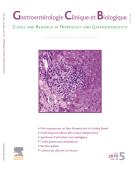Patient information for liver biopsy: impact of a video movie - 26/03/08
Stéphane OBLED [1],
Marianne MELKI [1],
Jessica COELHO [1],
Emmanuel COUDEYRE [1],
Jean-Pierre ARPURT [2],
Philippe POUDEROUX [1]
Mostrare le affiliazioniInformation du malade à la biopsie de foie: impact d'un film vidéo |
Objectifs |
L'information du malade avant un examen doit être classiquement faite verbalement et par écrit. La visualisation de l'examen sous forme d'un film pourrait aider à améliorer la compréhension du malade et diminuer son anxiété. Le but de cette étude prospective était de déterminer l'impact sur l'anxiété et la compréhension de l'ajout d'une information par film vidéo par rapport à une information standard pour la ponction biopsie hépatique (PBH).
Méthodes |
Les malades inclus dans cette étude recevaient une information verbale et écrite sur la ponction biopsie hépatique au cours d'une consultation. Les malades étaient alors randomisés pour visionner une cassette-vidéo d'information en plus de l'information standard. L'anxiété était mesurée par l'autoquestionnaire STAI-Y de Spielberger après la consultation puis juste avant la ponction biopsie hépatique. La compréhension de l'information et la satisfaction sur l'information reçue étaient évaluées respectivement avant et après la PBH.
Résultats |
Sur les 67 malades évalués, 33 avaient reçu une information vidéo. L'anxiété avant la ponction biopsie hépatique était similaire à celle mesurée lors de la consultation (avec vidéo: 38,8 et 37,4; sans vidéo: 38,9 et 40,1). La compréhension était excellente (avec vidéo: 12,3/14; sans vidéo: 12,7/14), ainsi que la satisfaction de l'information reçue.
Conclusion |
La compréhension et la satisfaction de l'information sur la ponction biopsie hépatique ont été excellentes. Une information filmée complémentaire de l'information classique verbale et écrite n'a pas modifié l'anxiété des malades.
Aims |
The information given to patients before a medical procedure is usually delivered verbally and in the form of a written document. Viewing a video movie about the procedure might be helpful in improving the quality of patient information and thus contributed to reduce patient anxiety. The aim of this prospective study on the methods used to deliver information to patients scheduled for liver biopsy was to determine, in comparison with standard information delivery, the impact on anxiety and understanding of additional information provided by a video movie.
Methods |
Patients included in this study were scheduled for liver biopsy. Three days before the procedure, a physician informed the patients about liver biopsy and gave them a written information document. After this standard information delivery, the patients were randomly assigned to two groups, to view or not a video movie illustrating liver biopsy and recalling the information provided in the information document. Anxiety was measured after the information visit and just before the biopsy procedure using Spielberger's self-administered STAI-Y questionnaire. Patient understanding of and satisfaction with the information received were evaluated respectively before and after the procedure.
Results |
Among the 67 patients retained for analysis, 33 viewed the information video and 34 did not. The level of anxiety measured at the information visit and before liver biopsy was similar in the two groups (38.8 and 37.4 with video versus 38.9 and 40.1 without video). The patients had an excellent understanding of the information received (12.3/14 with video; 12.7/14 without video) and were well satisfied with the information received.
Conclusion |
The patients understood and were well satisfied with the information received about liver biopsy. Complementary information in the form of a video movie had no effect on patient anxiety.
Mappa
© 2007 Elsevier Masson SAS. Tous droits réservés.
Vol 31 - N° 3
P. 274-278 - Marzo 2007 Ritorno al numeroBenvenuto su EM|consulte, il riferimento dei professionisti della salute.

